MX-5 Miata Becomes Bargain Exotic for 2016
By John Gilbert
Hurry! If you live in the warmer part of the country, there’s no urgency; but farther north, where the ominous approach of cold weather and a little snow and ice is nearing, sports car driving can become a seasonal venture, and the leaf-changing time of autumn might be the best time possible.
If you own a Porsche Cayman, or a Jaguar F-Type, an Audi TT, BMW Z4 or an Alfa 4C, there’s no real urgency, because you undoubtedly can afford to pick your spots. But if you want the same thrill, possibly amplified by the knowledge that you beat the system by spending about one-fourth of the required investment of the above-named roadsters, then run — don’t walk — to your closest Mazda dealer and pick off a 2016 MX-5 Miata for half the sticker price or less.
The base Miata Sport starts at $24,915, and moving up to the Club is $28,600, with the top Grand Touring starting at $30,065. The Club is what I drove, and it adds a limited slip and Bilstein shock absorbers and an inch larger wheels if you pick the Sport package.
Jump into the Miata, flip the closure lever and lower the top with one hand — no power gizmos, please. Start up the Skyactiv engine, shift into gear and take off. The feeling of exhilaration is instant and always the same. Fantastic. If it feels even more compact than you anticipated, it is. Its 154.4-inch length is more than an inch shorter than the original was in 1990, although wheelbase as 1.7 inches stretched on the new car, and width is a couple inches more.
With Mazda, the power and torque numbers mean very little. If it feels fast enough to give you a thrill, it is. The new Skyactiv 2.0 has 155 horses and 148 foot-pounds, and the outgoing 2.0, without Skyactiv technology, actually had more horsepower at 167 at 7,000 revs, with less torque at 140. I never know how Mazda does it, but the new car feels quicker in a more coordinated way where the engine, gearbox, electric power steering and suspension all contribute.
For 2016, even the crustiest traditionalist among Miata fans will have to admit that as good as the first three generations of the Miata have been, the fourth-generation version gives you the largest jump forward in technology, and also provides some visual exhilaration, from the first time you lay eyes on it.
First reaction to the term “sports car” is that it must have a rigid body that stays flat around the tightest corners, even if that means you risk outright harshness over any road irregularities in real-world driving. We accept that. Mazda, however, doesn’t. The new Miata has an almost surprising feeling of compliance — not softness, but a little bit of leaning in tight corners, and even a little nose bobbing under heavy braking. Maybe the Miata’s ability to feel comfortable and secure at all times, rather than steely, track-day firmness might cost you a second around a road-racing track. But you appreciate the compliance every time you get behind the wheel.
Also, when it comes to those hard-driving track day ventures, a little leaning in tight turns is no problem if it’s completely predictable, doesn’t cause you to compromise your driving aggressiveness, and actually gives a good driver time to anticipate the shifting G-forces.
Mazda has long established a reputation for building an honest “fun” driving experience into every vehicle it produces, and up on the pillar as the standard of Mazda’s “zoom-zoom” philosophy is the Miata. Actually, Mazda prefers us to call the car the “MX-5” for reasons best known to those image-makers in Hiroshima, Japan, who don’t seem aware of the enormous advantage of name-recognition. Grudgingly, the company now seems to allow its people to call it the “MX-5 Miata.”
By any name, Mazda’s 2-seat sports car has become a standard of the entire industry for being a simple, no-frills approach to flat-out fun driving. Competitors may attempt to challenge it, but nobody has come close to providing the same flair for the amazingly low price.
For 2016, the fourth-generation MX-5 Miata adds a decided new look and personality. Rod McLaughlin, the car’s vehicle line manager, stressed those four core values that Mazda would not alter: “Light weight, affordable, a roadster, and fun to drive,” he said. “Our job was to turn those principles into engineering. ‘Kansai’ engineering involves how it feels, sounds and looks. Takao Kijima, the third-generation manager, made sure all benchmarks turned into emotional values.”
McLaughlin’s challenge was to expand on the traditional simplicity of the Miata, while also incorporating the unique features that Mazda has made standard issue on all its vehicles. That includes high-strength steel for increased rigidity and lighter weight, plus the Skyactiv treatment whereby a compacted, stylish and streamlined look and design must keep up with Mazda’s new engine technology and self-made transmissions.
The term “Skyactiv” has become commonplace in publications, but don’t settle for superficial explanations that consist of the name without technical explanation. The true definition of Skyactiv springs from Mazda’s decision to look into the future and realize the company had to make a move to an entirely new way to build engines, and cars, if it wanted to rise above the 30-mpg norm to more like 40. Mazda’s holistic approach started with a design and production of an engine from the bottom up, inside out, with everything on the cutting edge of technology.
A simple glance at the beautifully tuned exhaust manifold pipes winding rhythmically around the block. That doesn’t fully explain that there is a chain-driven dual-overhead camshafts, direct injection, 155 horsepower at 6,000 RPMs and 148 foot-pounds of torque at 4,600 revs, and a redline of 6,800. The variable valve-timing can keep the valves open in Miller-cycle fashion, and fuel economy figures show 27 city and 36 highway for the automatic or 34 mpg for the 6-speed stick.
A trademark of the engine, when it was introduced on the Mazda3, then accompanied thorough revisions of the Mazda6 and the introduction of the crossover CX-5, is extremely high compression ratio but with the ability to burn regular gas. Stuffing all the technical advances into the 27-year-old heritage of the Miata had to be a major challenge, but Mazda pulled it off.
At a glance, the new car has the look of a small exotic more than a bargain sports roadster, starting with the large and comparatively menacing grille opening, with angular slits for headlight eyes, vast departures from tradition.
“At the time of the Miata’s 1989 launch, there were no true lightweight sports cars available,” said Lead designer Jacques Flynn. “This car has established such a rich pedigree as a true icon that it is a huge honor for me to be involved with it. It has always been the perfect light sports car — under 2,200 pounds — and we had to make sure we met our demands for technology but also tradition.”
Mazda gives you the option of using minimum 87-octane regular or 91-octane premium gasoline, noting that you will get full power with premium.
At the MX-5 Miata introduction in California, I had an early departure to fly back to Minnesota. Since my co-driver could spend the rest of the afternoon driving all versions of the car, I drove the first part. As it happened, our best efforts to follow the map and use all of our GPS instruments and our common sense failed when highway construction got us hopelessly lost.
We zoom-zoomed around all sorts of back roads and neat, twisty highways, and we finally arrived at the lunch stop by coming to the country club by the back way. The main issue with our wandering in the wilderness is that I had to drive the whole way. Oh darn!
I got an extreme dose of driving the Club version of the MX-5 Miata, and found it thoroughly enjoyable whether on freeway stretches or around tight curves and switchbacks. Can you use a little extra exhilaration in your life, even on a mundane drive to work? Of course. And the Miata, or MX-5, provides that, every day. But hurry, so you can beat the northern snow.


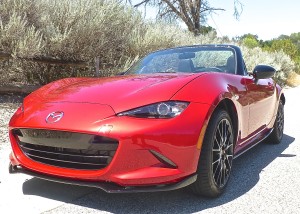
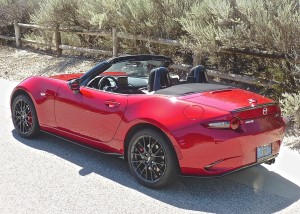
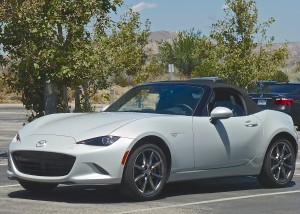
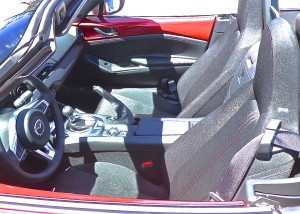
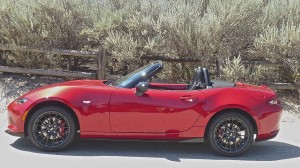
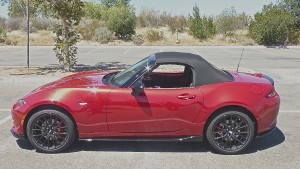
 John Gilbert is a lifetime Minnesotan and career journalist, specializing in cars and sports during and since spending 30 years at the Minneapolis Tribune, now the Star Tribune. More recently, he has continued translating the high-tech world of autos and sharing his passionate insights as a freelance writer/photographer/broadcaster. A member of the prestigious North American Car and Truck of the Year jury since 1993. John can be heard Monday-Friday from 9-11am on 610 KDAL(www.kdal610.com) on the "John Gilbert Show," and writes a column in the Duluth Reader.
John Gilbert is a lifetime Minnesotan and career journalist, specializing in cars and sports during and since spending 30 years at the Minneapolis Tribune, now the Star Tribune. More recently, he has continued translating the high-tech world of autos and sharing his passionate insights as a freelance writer/photographer/broadcaster. A member of the prestigious North American Car and Truck of the Year jury since 1993. John can be heard Monday-Friday from 9-11am on 610 KDAL(www.kdal610.com) on the "John Gilbert Show," and writes a column in the Duluth Reader.